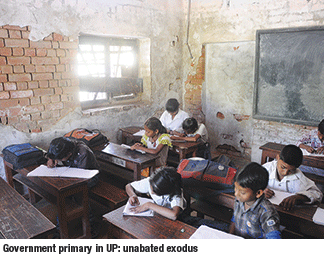THE RAIN OF WOES POURING DOWN ON THE STATE OD UTTAR PRADESH (pop. 200 million) — the Muzaffarnagar riots, legislators globetrotting at public expense and exacerbating breakdown of law and order — has been compounded by the release of the Annual Status of Education Report (ASER) 2013, published by the nationally reputed Mumbai-based education NGO Pratham (estb. 1994), which shows that primary education in the country’s most populous Hindi heartland state is in steep decline.
According to Pratham volunteers who conducted the survey by testing the reading, comprehension and numeracy of 93,272 students of 1,945 schools in UP’s 69 rural districts, the state is ranked among the country’s last five in terms of learning outcomes of primary school children. Only two of India’s 29 states and seven Union territories — Bihar and Rajasthan — are ranked below it.
One third of children in class III can’t read class I textbooks, a dismal performance worsted only by Madhya Pradesh and Bihar. Moreover, against the shocking national average of 53 percent of class V children who can’t read class II vernacular texts, in UP 56.2 percent class V children can’t read and/or comprehend class II textbooks. Similarly against the all-India average of 74.4 percent class V children who can’t do a simple division sum, 73.8 percent in UP cannot. Significantly, learning outcomes in Uttar Pradesh’s 65,720 private primaries are substantially better than in the state’s 155,157 government primary schools. Over 60 percent of class V children in private primaries can read class II texts cf. 28 percent in government schools. And whereas not even 10 percent of class V government school children can solve a simple (class III) division sum, 32 percent of children in the state’s private primaries can, says ASER 2013.
Little wonder, the exodus of children from the country’s poorest households into private fees-levying schools continues unabated. Whereas in 2006, only 18.6 percent of primary school children in UP were enrolled in private education, the proportion has shot up to 49 percent in 2013.
Roop Rekha Verma, member of the state’s Sarva Shiksha Abhiyan (Education for All) committee, attributes poor learning outcomes of children in government primaries to teacher absenteeism and outdated curriculums. “The state government has been entirely focused on gross enrolment ratio without bothering about the quality of education dispensed in primary schools. Revision of textbooks and training of teachers from time to time is absolutely necessary for improving learning outcomes,” says Verma.
R.P. Misra, a spokesperson of Madhyamik Shikshak Sangh (association of government primary teachers in UP) admits that government school teachers barely spend time teaching children. “Schools which should have five teachers are staffed by one or two. But even these few teachers are sent off for door-to-door census work and election duties by government officials. Too much paper work precludes them from teaching,” says Misra.
Analysing the state of affairs in UP, the report says there are serious implications for the state’s equity and growth, if the issue of abysmal basic learning outcomes is not addressed soon. “The guarantee of education is meaningless without satisfactory learning. Thus the state needs to focus on improving learning outcomes that are measured, monitored and reported independently at all levels of school education with special focus on ensuring that all children master basic reading and numeracy skills by class II and skills of critical thinking, expression and problem solving by class V,” recommends the report.
But with corruption, caste and communalism — pernicious social evils perpetuated by this Hindi heartland state’s dysfunctional education system — continuing to cast a long shadow over India’s most populous state, urgently required overhaul of deficient government schools will remain a low priority for Uttar Pradesh’s feuding politicians. Meanwhile the flight of desperate children to private schools will accelerate.
Apoorv Srivastava (Lucknow)























